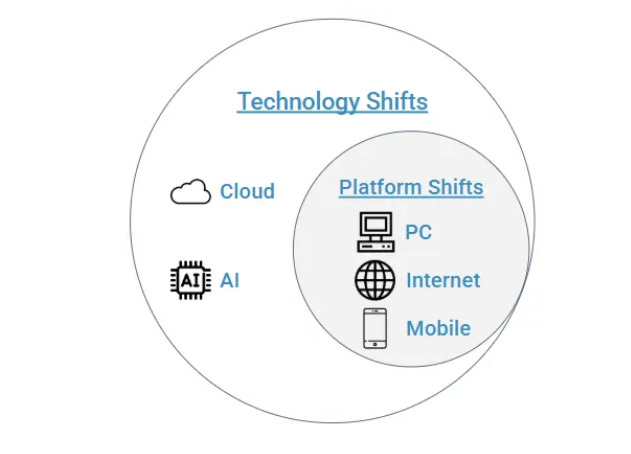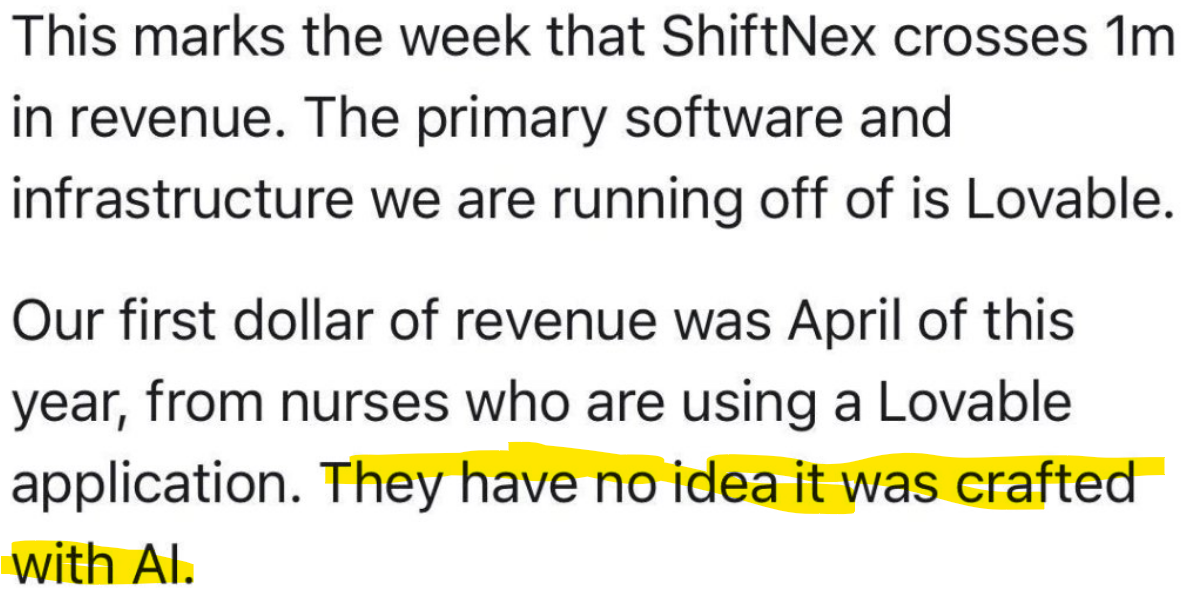Technology vs Platform Shift, Portfolio Change
Is the current AI phenomenon a technology or a platform shift? Or is it both? I read couple of pieces yesterday that makes a pretty convincing case that it is only a technology shift so far.
Casey Winters made this point almost a couple of years ago which I think still holds up pretty well:
What I realized having gone through the internet and mobile platform shifts is that the technological and distribution shifts did not happen at the same time. Platform shifts that create both technological and distribution opportunities happen in a sequence, not all at once…AI has come out and definitely created a technological shift that enables new ways to solve problems that couldn’t be done before. But AI lacks a new distribution channel. ChatGPT is “not it”, as the kids would say. At least not yet.
Sameer Singh elaborated this further yesterday with a thought experiment:
Let’s start with a thought experiment: In each of these eras, where would you find the early products?
- Where did you find early internet products? On the internet, i.e. you could access websites via web browsers.
- Where did you find early mobile apps? On smartphones, i.e. via app stores on the iPhone and Android phones.
- Where do you find AI products? … on AI models? Of course not. You find them on the internet or via app stores. This is the first hint that the shift we’re seeing with AI is not the same as the internet or mobile.
…a platform shift can only exist if the adoption of a new underlying technology gives users access to new products from that era. This creates a network effect between adoption of the technology and builders tinkering on top of the technology. The mass adoption of a new underlying technology with these characteristics can be described as a platform shift.
Adopting ChatGPT does not make it easier to access AI apps like Cursor or Lovable. And adoption of AI apps like Cursor or Lovable has no bearing on ChatGPT usage (or of any other LLM for that matter).
Casey Winters, however, does make the point that it is pretty early days. As he said, these shifts may not happen at once, but rather in a sequence which is what happened during earlier platform shifts as well. From Casey Winters:
we shouldn’t really expect new distribution shifts to have happened yet. The App Store launched in 2008, and even though there was fervor around discovering apps on the App Store for a while with the “there’s an app for that” campaigns, that fervor died as did most of the apps featured. It was when Facebook launched mobile ads four years later in 2012 that apps exploded into multi-billion dollar companies. This is similar to the internet. People started getting online around 1994. Google didn’t come out until 1998. Sure, there were search engines before that (Lycos, Yahoo!), but they lacked the predictable distribution of Google. Word of mouth can’t scale technological shifts alone. They need scalable distribution methods, and usually new ones that take time to become obvious.
So, as an operator, this feels like 1997 or 2008.
Sameer Singh also points out that “All platform shifts are, by necessity, also technology shifts. But not all technology shifts are platform shifts” and the diagram below makes that abundantly clear:

Sameer also points out that in a technology shift, users may not even be aware about the tech (it just works) whereas in a platform shift, the change is front and center for the user:
In a technology shift, form factor does not and should not matter. For example, scaling Snapchat’s picture messaging functionality would not have been possible without the shift to cloud computing. While Snapchat’s cloud hosting costs were significant, it would not have been possible to scale it as quickly if it relied on large, operationally complex investments into server infrastructure. The most important part — Snapchat’s end users did not know or care about this in any way. The user interface did not change to call out Snapchat’s “Cloud powered” technology. The biggest changes happened in the backend, not the frontend.
While scrolling twitter yesterday, I stumbled onto this tweet by Loveable’s founder. He was sharing how someone built a $1 million revenue business on top of Loveable in just 5 months, but one particular sentence caught my attention from that screenshot: “they have no idea it was crafted with AI” which does give credence to AI being a technology shift rather a platform shift.

A platform shift which creates new distribution channel is obviously more uncomfortable to deal with for existing incumbents. If you think from this perspective, it is easier to appreciate why OpenAI paid such top dollars to acquire “LoveFrom”. I interpret this mostly as OpenAI’s ambition to propel AI graduate from technology shift to platform shift. At least that’s what I think Sam Altman is likely assigning Jony Ive to accomplish. I may sound a little skeptical about OpenAI’s soaring valuation these days, but I do not doubt that OpenAI is the most dangerous company which can create a jolt in the current big tech landscape and almost three years after ChatGPT’s launch, it may still be early to sketch their level of ambition.
In addition to "Daily Dose" (yes, DAILY) like this, MBI Deep Dives publishes one Deep Dive on a publicly listed company every month. You can find all the 62 Deep Dives here.
Current Portfolio:
Please note that these are NOT my recommendation to buy/sell these securities, but just disclosure from my end so that you can assess potential biases that I may have because of my own personal portfolio holdings. Always consider my write-up my personal investing journal and never forget my objectives, risk tolerance, and constraints may have no resemblance to yours.